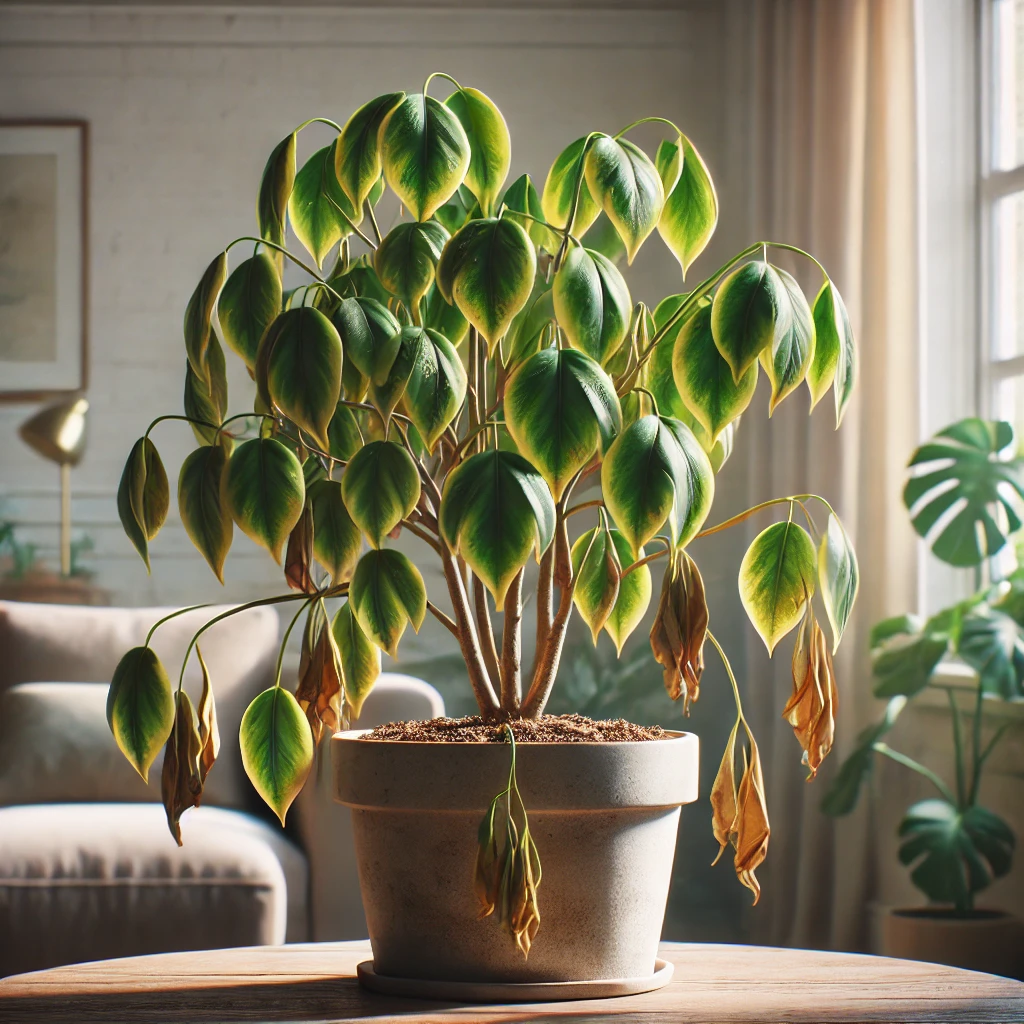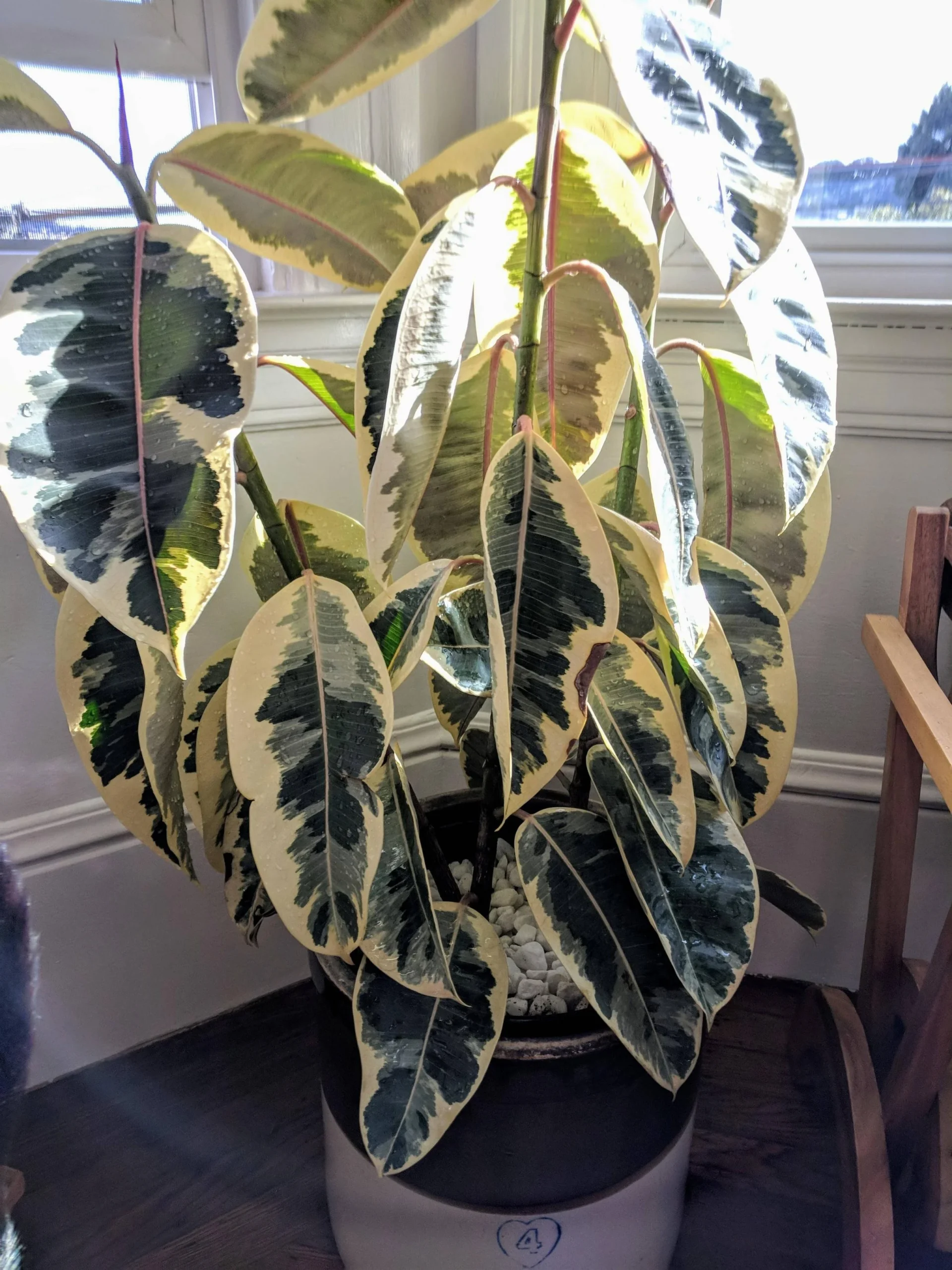Ficus (Ficus) – a popular decorative houseplant that has won the love of many homeowners due to its elegance and ease of care. However, even experienced gardeners encounter situations when the ficus starts shedding leaves. In this guide, we will explore the possible causes of this problem in detail, teach you how to diagnose it, and provide recommendations for restoring the plant’s normal condition.
Main causes of leaf drop
Insufficient moisture

One of the main reasons for leaf drop is insufficient watering. The ficus, like most tropical plants, requires regular moisture, especially on hot summer days.
- Problem: If the plant does not receive enough water, the leaves begin to dry out and fall off.
- Recommendations:
- Water the ficus regularly, based on the moisture of the top layer of soil.
- Wait until the top layer of soil dries out a bit before the next watering.
- During hot periods, it may be necessary to increase the frequency of watering, but avoid water stagnation in the pot.
Excess moisture

On the other hand, overwatering can be equally harmful. Waterlogging leads to stagnant water, which causes root rot.
- Problem: Root system rot causes stress and leads to leaf drop.
- Recommendations:
- Use a pot with drainage holes to avoid water stagnation.
- Reduce the frequency of watering if you notice signs of excess moisture (yellowing leaves, soft or dark roots).
- After watering, ensure that the soil has enough time to dry out.
Lighting: deficiency or excess

The ficus requires the right balance of light for normal growth.
- Insufficient light:
- Problem: A plant located in the shade or a dark room may become weak, which is expressed in leaf drop.
- Recommendations:
- Place the ficus in bright, but not too direct sunlight.
- If natural light is insufficient, use special lamps or LED panels for additional lighting.
- Excess direct sunlight:
- Problem: Excessive direct sunlight can scorch the leaves.
- Recommendations:
- Provide diffused light or use thin curtains to soften the intensity of sunlight.
Temperature fluctuations and stress

The ficus is very sensitive to sudden temperature changes and drafts, which can cause stress to the plant.
- Problem: Sudden temperature drops, cold drafts, or placement near air conditioners and heaters negatively affect the ficus.
- Recommendations:
- Place the plant in a location with a stable temperature, away from sources of sudden cold or heat.
- Avoid placing the ficus near open windows or doors where cold air can enter.
Improper nutrition
The ficus, like any other plant, requires nutrients for normal growth.
- Problem: A deficiency or excess of fertilizers can lead to disruptions in the plant’s life processes.
- Recommendations:
- Use specialized fertilizers for houseplants, following the recommended dosage.
- Pay attention to seasonality: during the active growth period (spring-summer), the plant requires more nutrients, while in autumn and winter – less.
- Periodically fertilize to provide the ficus with the necessary micro- and macronutrients.
Additional factors
There are other aspects that can also affect the condition of the ficus:
- Pests:
- Signs: The presence of spider mites, scale insects, or other small insects can cause damage to the leaves.
- Recommendations:
- Regularly check the leaves (both top and bottom) for pests.
- If detected, use natural or chemical insecticides according to recommendations.
- Transplanting and soil quality:
- Problem: Stress from transplanting or using poor-quality soil can lead to leaf drop.
- Recommendations:
- Transplant the ficus every 1–2 years, using fresh, well-drained substrate.
- Consider the size of the pot – too tight a space can restrict root system growth.
- Diseases:
- Signs: Spots on leaves, softness, or distortion may indicate fungal or bacterial infections.
- Recommendations:
- If disease is suspected, consult a specialist.
- Follow hygiene rules by removing affected leaves and treating the plant with appropriate means.
Diagnosing problems
To accurately determine why your ficus is dropping leaves, follow these steps:
- Examine the root system:
- Carefully remove the plant from the pot.
- Check the roots: they should be light, firm, and free of signs of rot. If the roots are dark or soft, this may indicate excess moisture.
- Analyze the soil:
- Assess whether the soil provides adequate drainage.
- Ensure that the substrate does not retain excess moisture.
- Evaluate lighting and temperature conditions:
- Ensure that the ficus receives enough, but not excessively intense light.
- Monitor the room temperature and avoid drafts.
- Inspect the leaves:
- Pay attention to color, texture, and the presence of spots. Yellow or brown shades may indicate either a lack of water or excess watering or other stress factors.
- Check for pests:
- Inspect both the upper and lower surfaces of the leaves.
- If small insects or webs are found, take measures to combat the pests.
Recovery and prevention tips
To maintain the health of your ficus and prevent problems from recurring, follow these recommendations:
- Regular and balanced watering:
- Establish a watering schedule according to your plant’s needs.
- Use a watering can with a fine spout to avoid damaging the roots.
- Optimal lighting:
- Provide the plant with bright, but diffused light.
- If natural light is insufficient, supplement it with artificial lighting (e.g., using LED lamps).
- Stable temperature:
- Place the ficus in a room with a constant temperature, avoiding areas with strong drafts.
- Ensure protection from direct streams of cold or hot air.
- Quality nutrition:
- Fertilize the ficus with specialized fertilizers for houseplants.
- Follow dosage and seasonal fertilization guidelines.
- Regular inspection and prevention:
- Periodically inspect the plant for pests and signs of disease.
- If problems are detected, promptly apply appropriate means to address them.
- Transplanting and soil care:
- Transplant the ficus every 1–2 years, using fresh and well-drained substrate.
- Monitor the pot size to ensure the root system has enough space to grow.
Final thoughts
Leaf drop in ficus can be caused by various factors: from insufficient or excessive watering to lighting issues, temperature fluctuations, improper nutrition, pests, or diseases. The most important thing is to carefully monitor the condition of the plant and timely adjust its care conditions.
By applying the above recommendations, you will not only be able to stop the leaf drop but also improve the overall condition of your ficus, allowing it to bloom again and beautify your interior. Caring for plants is a process that requires patience and attention, but the results are worth your efforts.
We wish you success in caring for your ficus!
